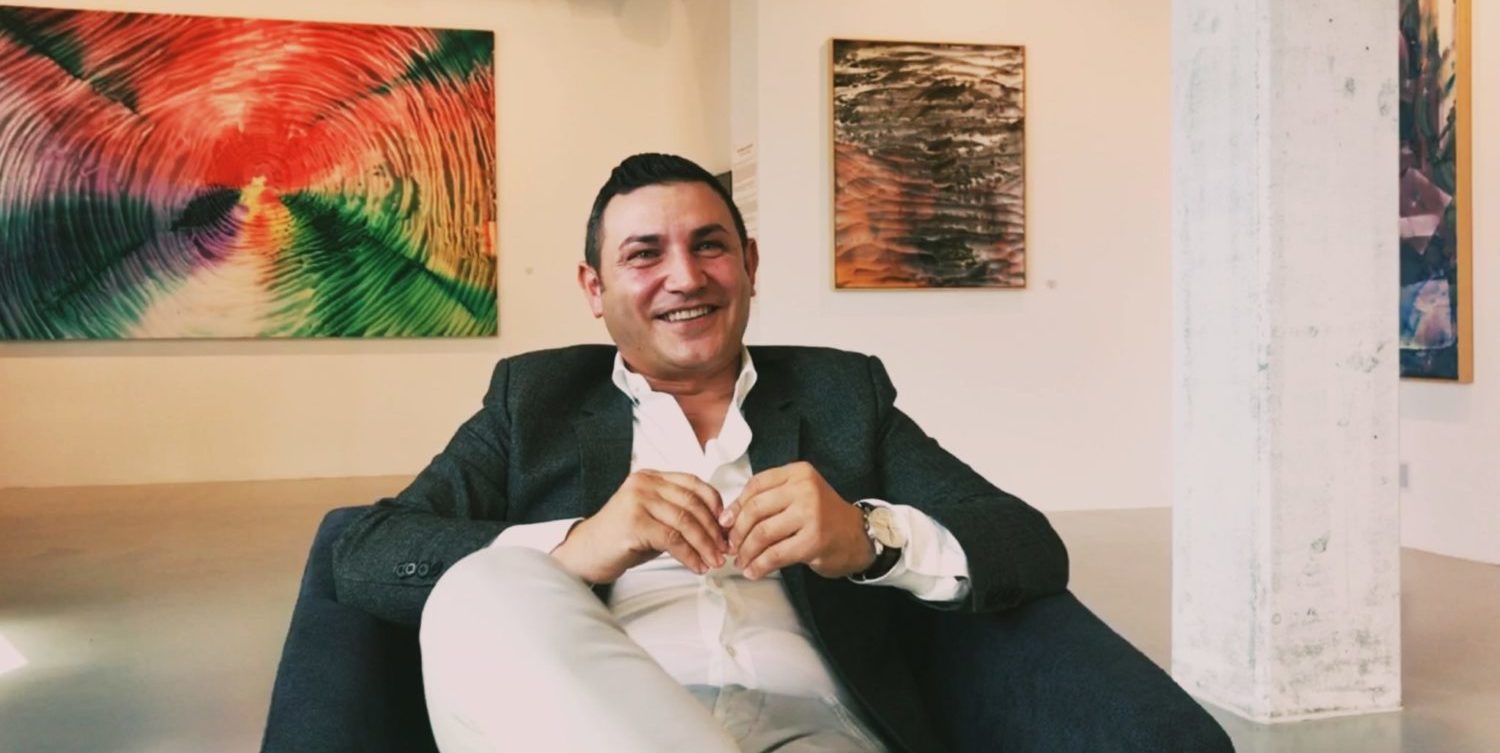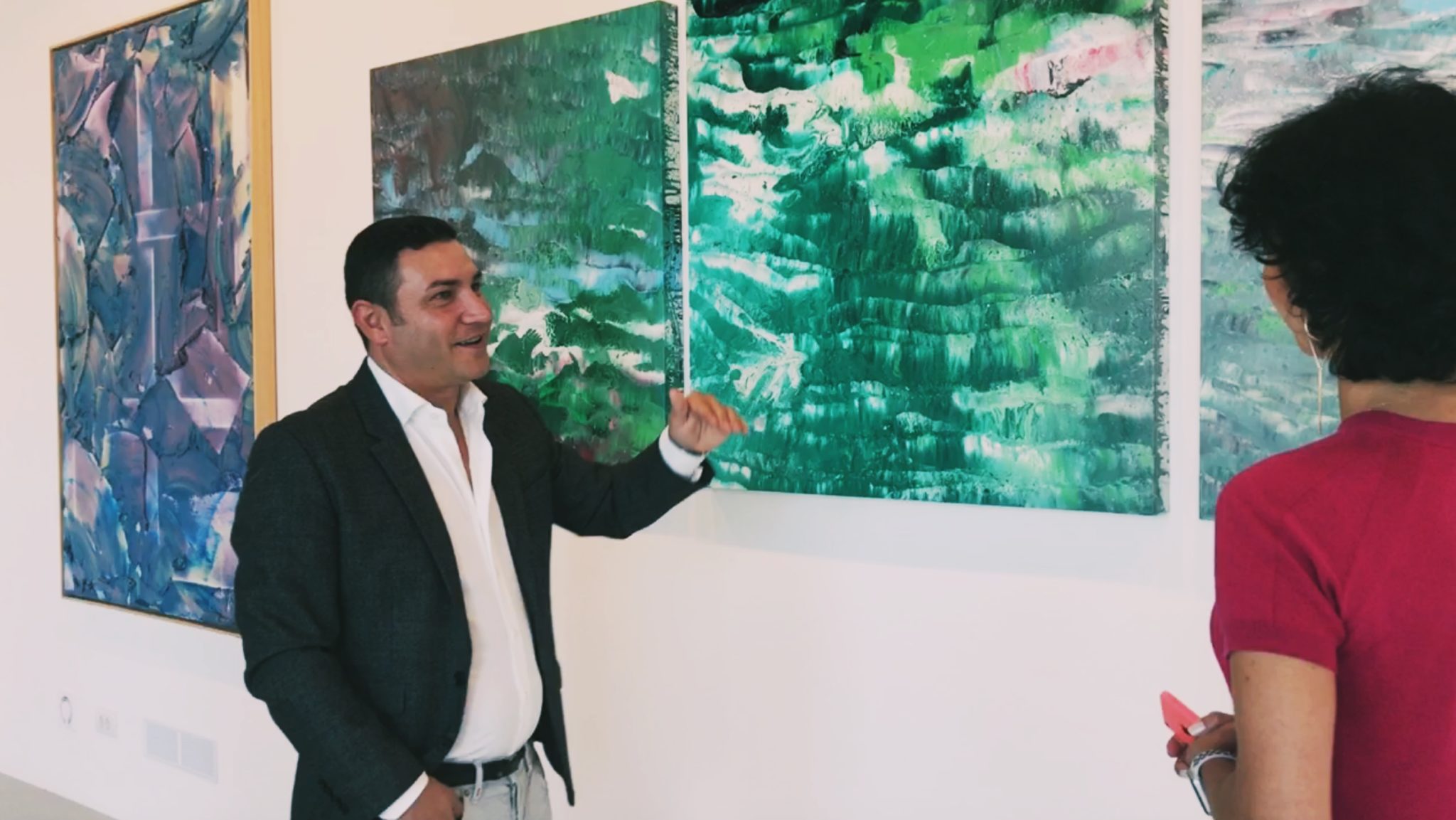Galleries are the beating heart of the art world, the mechanism through which many artists find their way to institutions, the world’s great collections, or just the homes of people who love their work. Galleries have multiple roles, both visible and invisible: to incubate and support their artists, often by going above and beyond the normal work of putting on shows, promoting their artists, and selling the works; and to providing services such as financial management or book publishing, in order to help their artists focus more fully on their work. Regardless of size, at the core of a gallery’s identity is its “program.”
The art for our guest is a “food for the brain”, it’s the energy exchange and his passion. He spends days and nights researching the art world and finds the artists, who inspire, innovate and convey a message via the extraordinary artistic vision. Vincenzo Maccarone, a director of the MC2 Gallery in Italy and now in Montenegro, speaks about the role of a gallery in art, his latest representation in Montenegro, and artist-gallerist-buyer connection.
OU: Tell us about MC2 Gallery – what sort of work do you represent?
VM: I’m a co-founder and a director of the gallery. I also have a partner Claudio Composti. He is my close friend and a big brother; a very well-known person in the art in Italy because he grew up among the most important trans-avant-garde Italian artists. We set up the gallery in 2009 and wanted to work with young artists, discover young talents in Europe and in the US. Most of the art, represented in our gallery, is around photography. But we also work with painters, installations, and video artists. Art is art. Contemporary art is contemporary art. We have a contemporary art gallery.
OU: Traditionally artists have been told to approach galleries with informational packets and portfolios, but perhaps with the internet, the approach has changed. How do you find most of the artists that you represent?
VM: Yes, the internet is very important in the life of our gallery. We have our gallery’s Instagram profile. It helps to save time because if you are a gallerist, you see thousands and thousands of images a day. But sometimes, you can be wrong in understanding if the artist is interesting for the gallery or not. Though still, we found one artist on Instagram. But usually, as we travel a lot around the world in the art fairs of Europe, USA and Asia, we find artists there. Also, we pay attention to the artists working with other galleries. If the work of any of them is interesting, we start talking to him, call him or have a conversation with a gallery. This is our approach to choose an artist.
OU: What is the biggest mistake you see emerging artists make when approaching you? Is there anything in particular that screams “don’t take me!”? On the flip side, what makes an artist attractive to a gallery?
VM: We receive around 50 emails a week from the artists, who want to show their portfolio. Most of them are not for us, because we have a certain concept of the art line (a program), to which we adhere to. Also, it is a matter of taste. There are thousand different artists and photographers, particularly. The biggest mistake of young artists is their ego. And not only that. Sometimes they don’t know how the art galleries work. Also, artists from different countries have a different approach to the art: Chinese are different from Asian, Montenegrin, Italian, French or New York, which is, by the way, different from the US. The ego is something that I don’t accept. They should understand that the work of gallerist and artist is a teamwork. If you don’t have that feeling, you can’t work together.
In regards to your last question (what makes an artist attractive to a gallery?), again it is a feeling and a meeting each other personally in the artist’s studio. Usually, when we travel we always go to the studio of the artists, and in 90% of cases, you know that you want to work with this artist. Of course, it is also important to understand if the artist wants to work with us. And again without mutual feeling, we can’t work with any kind of artist.

OU: What qualities do you cherish and appreciate in the artist? What mindset you are looking for?
VM: Professionalism and kindness. Also, it is very important that people don’t work in art just for selling. The world of art is very small. No matter if you are an art lover, a collector, a gallerist, an artist, the most important is a passion for art. Without passion, you can’t do this job. We don’t sell glass or decoration, we sell art.
There are many many nice painters, but not that many nice artists. To be an artist, your ability to paint is not that important. The idea of an artist is very difficult to explain, you don’t know what you will find tomorrow, you can’t predict creativity. There are many art galleries. For example, in Milan, you will find around 300. And still, there are many talented artists that nobody knows, who don’t work with any gallery. Why? Because most of the galleries just take the artist if it is easy to sell. And this is not our way. We are a research gallery because we choose something that is more than a nice painter or nice picture, something intellectual. That’s why many museums and institutions, particularly in NY, London, Paris, and Italy of course, open the door to us because for them such an approach to the art selection is crucial.
OU: To what are you saying WOW?
VM: As an example, in the past, there was a very good artist, Lucio Fontana, he just painted one color and then cut the canvas. Nobody understood this art, this wasn’t an art. But those, who understood immediately, they won. Now this artist is crazy expensive, over 1 mln euro per painting. The galleries at that time had a lot of knowledge because when you inside of art world you must know psychology, philosophy, history, religions. You must study. Our job is not just put artworks in the wall. To make this exhibition we must organize everything one year in advance, talk many times with the artist, choose the paintings, and prepare a space. I am myself often spend all night to study and I’m more than 20 years in this business. If you want to stay at the high level you must expand your knowledge in different directions, like a soccer player, who must care about not only physical training, but also psychology, nutrition and other things. This is the only way to win. The same is with the world of art.

OU: What is the culture of purchasing artworks?
VM: It’s very, very important that the people study, travel and spend more time around the art, meet it, before investing in the artwork. The contemporary world is a little bit different. You can notice it in the relationships between men and women. Nowadays people use social networks and think they know each other. It’s not real, that’s the problem. Exactly the same in the market of art.
OU: You have to know it, feel it.
VM: Absolutely. Sometimes we help collectors to understand if that’s the right art for them. They come every day to see it and every day they have a different or new feeling. After one week in 99%, they can make a positive decision. Art is energy. It is a lot of work, of course, but it is energy. What also important form our side is a presentation of art, particularly lightning. Here we have special lights from Italy. Spotlights don’t work for the art gallery because you must see everything. Also, very artwork must have different lighting.
OU: So, Vincenzo, do you think the gallery scene has changed during the past 5 years or 10 years and do you think it’s gonna be changing in the future, in the near future?
VM: Of course, art is something that must change. In Europe, many galleries open and close because this is normal. Mostly because a real gallery cannot survive alone, it needs a sponsor, for the first ten years particularly. As for Montenegro, more galleries have opened and more people started being interested in art these days in comparison to five years ago. I think it might be due to the increasing volume of the foreign visitors in Montenegro. And it is always good, especially, when we talk about culture. It is very important for Montenegro to continue organizing exhibitions, so more people go to the museums and expositions, instead of shopping centres.
OU: And how did Montenegro actually came on your radar of exhibition spots?
VM: Montenegro is a place that I really love. I’ve lived in many big cities. My last one was Saigon (Ho Chi Minh City). I tried to live in a city with 15 million people and high pollution. First of all, in my opinion, if you have a family, Montenegro is one of the best places, when it comes to the quality of life. The second, it is very important that the economy started to benefit from not only the Balkan area investments but also from many other parts of the world. And, finally, nature is amazing here. Also, local people, are very nice.

OU: So Vincenzo, what actually artist expects from the gallery and on the other way around, what the gallery expects from the artists, sales- and marketing-wise, and is there a time, a certain point when the gallery decides to drop the non-selling artist?
VM: Usually the artists expect from the gallery intellectual support. To be close to them. Sometimes economic or financial support, for example, production of the catalog, exposition in the gallery, in the art fairs, which are very many around the world. Sometimes exhibition at a local level.
What a gallery expects from the artist is to be professional and to trust us. Because it’s important. Sometimes it happens that the gallery doesn’t sell anything for a long time because the artist will be recognized in the future. It is not easy for the gallery to let the art collectors understand immediately how important is one artist and his work. There are many (I’m one of them [laughs]), many art collectors who are very difficult. They must take time to understand the artist. They maybe want to know the next project, or they might want to visit the studio of the artist. They need time. Often the collaboration depends on the kind of relationships between gallery and artist. And sometimes artists are not happy if you don’t sell quickly, so they want to leave the gallery. Or, the other way around, if they’re not professional enough, I let them go. But there are also artists, whose works, which were created 6 years ago, are just starting now to be recognized by the audience. When they were making the artwork, they were 6 years in the future. And now they are very famous because this is the time which is required for the audience to start understanding their art. You should trust the gallery or gallerist in this case and be patient.
OU: Every artist has a dream gallery that they want to be represented by. Do you have your dream artist that you want to represent?
VM: Yes, my dream artist that I want to represent is Anselm Kiefer. But the problem with the Kiefer, is that our kind of gallery is boutique. We are still in the world, where huge galleries operate. We are not rich and famous enough yet for such artists.
OU: You will become.
VM: I hope. But it’s not important. What important is to work at a high level, work always with the mind and soul, and do something that is really meaningful to us because the quality of life is not only money. This is critical. Yes, it’s Anselm Kiefer, absolutely.
[tg_youtube width=”” height=”” video_id=”aCz57nkMTKk”]
OU: And let’s talk about Roberto Coda Zabetta. Why Roberto was chosen for this gallery and what personal touch, what you have on a personal level with his art?
VM: We chose Roberto Coda Zabetta for many reasons. First of all, we started working with him many years ago and had already organized exhibitions in a few museums in Italy. Not only Italy but also the MAC in Rio de Janeiro (one of the most important museums in South America), Palazzo di Arti in Milan, and in Palazzo Reale in Napoli.
We chose him for exhibiting in Montenegro because he’s one of our gallery’s painters. Most of our job is around photography. But for Montenegro, we wanted to choose some important project because we wanted to expose the full depth of our profession to people. So it was difficult to organize. This art is “informal”, which means that people usually perceive it as ‘’oh, I can do that as well’’. But really, it is the synthesis of many ideas. It is important to understand what Roberto Coda Zabetta created in the past, his knowledge, background, and biography, in order to understand why now he does something like that. These works are created without touching anything, he used a high compressor. At the same time, he works with all his body on his art, but he doesn’t touch it. It’s a new concept of paint. Also, if you look at it you can think that it is something created so many times by other artists, but it is completely different. That’s why with this painter we have a big programme now, which involves a museum, exhibition, and other expositions. Montenegro is an important location for me, that’s why I wanted to organize a serious exhibition like this for the opening.

OU: So Vincenzo, the last question. Why do you do what you do?
VM: Absolutely for love. I fall in love with art. Art for me is something very important in my life. It is a real food for my mind. Because art lets me think, lets me discover. You know, in every artwork there is a history that we must discover. And sometimes you need to stay with this artwork for a long time and look at it every day and then you can discover something. It’s exactly like when you read a book and you read it again because you have a new experience. Also, when you are very close to artworks you feel a lot of energy. And at the same time, art for me is also a business. I opened my gallery 10 years ago because I wanted to help talents and good artists not to become famous, but to let them do what they love because they need somebody, who believes in them. To be an artist today is one of the most difficult jobs because people don’t recognize you as an artist immediately. But it’s more than a job because behind the painting or picture (shot) they show you their personal life. Every painting is a book. That’s why it is a real artwork.


